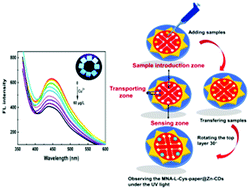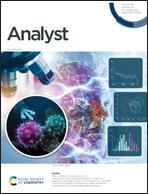Anchoring zinc-doped carbon dots on a paper-based chip for highly sensitive fluorescence detection of copper ions†
Abstract
In this work, zinc-doped carbon dots (Zn-CDs) were anchored on a three-dimensional wheel type paper-based microfluidic chip, and were decorated with 6-mercaptonicotinic acid (MNA) and L-cysteine (L-Cys) for highly sensitive and rapid fluorescence detection of Cu2+. Zn-CDs were first anchored on paper through the amide bonds between the carboxyl groups of the Zn-CDs and the amino groups of the paper. Afterwards, Zn-CDs were decorated with MNA and L-Cys, effectively preventing the Zn-CDs from aggregation. The nitrogen atom on the pyridine ring and the carboxylic acid groups in MNA and L-Cys coordinated with Cu2+ to form a nonfluorescent ground-state complex, causing the fluorescence quenching of the Zn-CDs. The three-dimensional rotary design could simplify the operation process and achieve simultaneous analysis of multiple samples with different concentrations. Under optimal conditions, the fluorescent sensor exhibits linear response for the determination of Cu2+ in the range from 0.1 to 60 μg L−1 with the detection limit (LOD) of 0.018 μg L−1. The proposed strategy provides a novel way for the highly sensitive detection of Cu2+ in a complex water environment.



 Please wait while we load your content...
Please wait while we load your content...